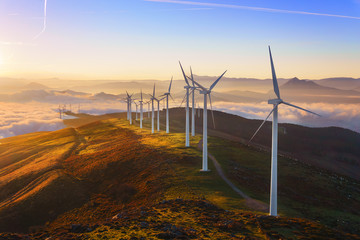
TRUMP SAYS: HUNTER MAKES FORTUNE FROM SHADY DEALS!
BIDEN FAMILY STINKS TO HIGH HEAVENS OF CORRUPTION!
DON'T GET LEFT OUT: HUNTER MUST BE STOPPED!

This article was originally publisehd by Rhoda Wilson at The Daily Exposé.
Wind turbines are not only damaging to the environment and wildlife, but they pose risks to human health as well.
In the following article, Norwegian historian Stephan Sander-Faes highlights recent reports that damage to wind turbine rotor blades could release not only sharp-edged, larger fragments but also very fine, respirable fiber dust from carbon fibers, so-called “nasty fibers.”
These fibers are as carcinogenic as asbestos and can get into our bodies through our skin and our lungs. It is not only humans that these fibers pose a risk to, it is animals as well.
They have known about these “nasty fibers” emitted from windmill blades for over a decade.
By Epimetheus
We’ve heard a lot of concerns and protests about windmills, ranging from emotional pleas (they kill animals) to conservationist notions (they are ludicrously expensive to build), and from ecological concerns (just think about all the energy and raw materials to build them) to their questionable “sustainability” (what happens with them when the wind doesn’t blow).
There are no really good answers to any of these questions, and we could add some more, e.g., the rotor blades come from halfway around the world, they spoil the view, and the intermittency of their operation requires massive additional infrastructural investments into the grid, transformers and the like.
And now I found yet another concern, but you’d better read that for yourself.
Translation and emphases are mine, as are the ‘Bottom Lines’.
Carcinogenic “nasty fibers” can be released in the event of fires and breakages -recycling is not yet possible
By Dagmar Jestrzemski, Preußische Allgemeine Zeitung, 20 December 2022 [source]
At the Alfstedt wind farm in the district of Rotenburg/Wümme in Lower Saxony, the blade of a wind turbine rotor snapped off on 15 September [2022]. After 14 days, it broke off completely. The wind turbine had only been put into operation for a few weeks. Since then, sharp-edged large and small particles have been trickling down from the large breakage point onto the surrounding agricultural land.
Local residents are concerned because, according to a report in the Zevener Zeitung newspaper on 28 November [2022], fine fibers of the material are said to have spread throughout the community. The damage to the rotor blade could have released not only sharp-edged, larger fragments but also very fine, respirable fiber dust from carbon fibers, so-called nasty fibers [orig. fiese Fasern, Carbon-fiber reinforced polymer, but note that the English-language Wikipedia entry doesn’t mention any health effects], which can penetrate the organism of humans and animals via the skin and lungs.
Composite materials used to make rotor blades are glass fibers (“GRP”), balsa wood, steel elements, and, in the case of very large blades, carbon fibers (“CFRP”) are bonded with epoxy resins. These contain toxic substances such as bisphenol A [one of the more dangerous “forever chemicals,” which has a long and sordid history of human health risks]. After GRP was used as the main component for a long time, manufacturers are increasingly using plastics reinforced with carbon fibers (CFRP) to save weight.
The fibers are embedded with the plastics in a mold and cured by heating. The result is a hard-wearing, high-strength material that is lighter than steel. CFRP is regarded as the material of the future and is also used in the aerospace, automotive, and construction industries.
However, in the event of a fire at temperatures above 650 degrees Celsius, the ashes of the CFRP plastic release respirable fibers, which the World Health Organisation (“WHO”) considers to be as carcinogenic as asbestos. As burning wind turbines cannot be extinguished due to their great height, this results in uncontrollable emissions of “nasty fibers,” with the weather conditions determining the direction and spread of the highly hazardous dust. In 2014, the Federal Office of Infrastructure, Environmental Protection, and Services [orig. Bundesamt für Infrastruktur, Umweltschutz und Dienstleistung] of the German Armed Forces warned of respirable carbon fiber particles after fires.
The government is ignoring this danger to people, animals, and the environment. There are no legal regulations, for example, to define sufficient minimum distances between burning wind turbines and residential buildings. As a result, the Augsberg volunteer fire brigade (Upper Palatinate) had no information about the need for protective clothing and breathing apparatus when three young people, the junior firefighters, were given the task of collecting debris from a broken rotor blade from the neighboring forest at the Illschwang wind farm in May 2018.
According to the utility company, Energiekontor of Bremen, no construction vehicles were available in Alfstedt to remove the damaged rotor blade at the end of November. However, the company is endeavoring to eliminate the adverse effects on landowners, tenants, and residents, as well as the environmental pollution caused by the contamination as quickly as possible [boilerplate corporatese]. A contractor had also been commissioned to inspect and clean the areas. However, the owners of the adjacent meadows and fields are convinced that the fine fibers will never be removed from the agricultural land. For the manufacturer General Electric, the damage could be immense if the soil has to be replaced on a large scale.
Despite expensive research, there is still no solution in sight for recycling the ever-increasing quantity of dismantled rotor blades on an industrial scale [here’s a quick question for all ‘the experts™’: any takers? I mean, it’s essentially the same with “old” electronics, e.g., cell phones, laptops, tablets, you name it]. Glass fiber-based rotor blades can be used as secondary fuel in the cement industry after complex pre-treatment. Composite materials with carbon fibers are much more problematic. They only decompose during incineration at much higher temperatures than those prevailing in a waste incineration plant. They are also not recyclable. Worldwide, the rotor blades of disused wind turbines are mainly buried in landfill sites [what a wonderful ‘solution™’; it’s the same with asbestos-contaminated building materials, by the way: care to guess why?], which, according to architecture professor Lamia Messari-Becker, often also happens in Germany if the rotor blades cannot be sold abroad. Around 29 tonnes of plastic [sic] end up in the ground with each rotor blade.
According to studies from the Netherlands, dozens of kilograms of microplastics are whirled hundreds of meters into the atmosphere every year as splinters and fine dust during the use of the plants due to wear and tear, some of which sink to the ground or into the oceans at great distances. Around 1,141 million tonnes of composite material are produced in Europe every year. Germany accounts for the largest share of this at 225,000 tonnes [mind you, these numbers are 2-3 years old; I’m guessing they are higher now].
First up, “nasty fibers” are a serious health hazard. According to the German Wikipedia, this can be read there (references omitted):
Health Concerns [orig. Gesundheitsrisiken]
The mechanical processing of CFRP, in particular machining (sawing, milling, drilling, grinding, etc.), produces carbon fibre particles that can have a carcinogenic effect.
“The increasing use of CFRP is closely linked to the increase in bonded joints to ensure fibre-compatible joining. However, machining processes are sometimes required to produce bondable surfaces. The resulting carbon fibre particles are considered to be potentially carcinogenic, so that appropriate occupational safety precautions are required.” [via Hubert Pelc (source)]
According to experts from the German Armed Forces, a fire involving CFRP releases fibres that could have an effect comparable to asbestos. Above all, this would pose a risk to helpers at the scene of an accident, such as firefighters or police officers [source]. One expert cites a radius of approx. 300 metres around an accident involving burning CFRP as a guideline.
I’ll add the source for the last above sentence, which hails from 2010 (!): Norbert Simmet, ‘Nasty Fibres – Danger for First Responders’ (orig. ‘Fiese Fasern—Gefahr für Rettungskräfte’, Merkur, 13 Dec. 2010).
Second, none of these concerns have been addressed since then, as the below comment from an activist anti-windmill website Umwelt-Watchblog.de shows:
CFRP (carbon fibre-reinforced plastic) is regarded as the material of the future. It is light, stiff and very strong and is increasingly being used in vehicle and aircraft construction as well as in wind turbines. In the event of fire, however, the carbon fibres reach temperatures of more than 650 degrees and reach a critical size that can penetrate the lungs, according to Prof. Sebastian Eibl from the Institute of Military Science in Erding.
As the engines of the wind turbines cannot be extinguished in the event of a fire at a height of 160 metres, fire brigades are forced to limit themselves to cordoning off the danger zone with flutter tape, depending on the wind direction and spread, and hope that the flying burning parts do not trigger secondary fires on the ground…
There are no official statistics on wind turbines that have caught fire; the number of wind turbines that have now been damaged is deliberately concealed by the federal and state authorities and the wind power lobby so as not to alarm the public in view of the health risks caused by fires and the highly toxic fibres. Unofficial statistics cite around 30 to 40 wind power fires per year; however, due to the lack of official statistics, the number of unreported cases is likely to be higher. As a result of the current acceleration of wind power expansion, it can be assumed that the number of fires caused by wind turbine accidents and the health risks caused by the release of toxic and highly toxic fibres in the vicinity of the turbines will increase significantly throughout Germany and the country.
This was written by Hansjörg Jung in late Jan. 2023.
Finally, since these carbon fiber-reinforced polymer materials are also used for airplanes (think also: fighter jets), helicopters, trains, and light rail units, as well as, possibly, for cars, the potential for danger is commensurate – big. Just consider what happens if there’s an accident …
Here’s what Prof. Sebastian Eibl wrote back in 2017:
A final assessment of the toxicological effects of carbon fibres is still pending. Compared to the asbestos problem, there is a lack of corresponding long-term experience. In principle, however, there are similarities with asbestos. The carbon fibre material is also chemically non-reactive. The harmful effect on health is therefore primarily due to the critical fibre geometry. It is also more difficult to break down the material in the alveoli of the lungs, as macrophages are unable to enclose these fibre fragments, mainly due to their length, and die in the process. It is therefore very likely that inhaled fibre dusts remain in human lung tissue for a very long time …
According to the technical rules for hazardous substances, demolition, renovation and maintenance work with old mineral wool (TRGS 521) and the ‘Risk-related measures concept for activities with carcinogenic hazardous substances’ (TRGS 910), various protective measures must be taken at the fibre concentrations determined in order to avoid exposure to critical fibre dust. This includes wearing personal protective equipment with a fine dust mask (FFP3), eye protection, gloves, and a disposable protective suit. Avoid releasing fibres when handling burnt CFRP material. Material to be disposed of should be packed dust-tight in plastic films/bags …
In the accident situations described, a hazard from acutely toxic fire products or other accompanying fire symptoms must be regarded as…critical. This limits the potentially endangered group of people to rescue personnel and police in the event of repeated exposure [to say nothing about the victims helped by first responders]
So, now you know.
According to the simple formula, “show me the incentive, and I’ll explain the outcome” we can also see why there’s a culture of silence around these problems: it’s a massive grift-cum-boondoggle, paid for by the so-called ‘Green™’ shift of economy and society.
This will only end if politics in Brussels changes.
Epimetheus is a pseudonym adopted by Stephan Sander-Faes who is a historian of early modern and modern European civilization at the University of Bergen, Norway. He began his Substack page ‘Die Fackel 2.0’ not only to publish his own articles but to publish translations of what he perceives as important information that is unavailable to an English reader or international audience.
He covers contemporary politics, from a specific Central and Eastern European perspective, with a partially Scandinavian bent, thereby providing context to several political and historical issues that may otherwise be inaccessible to the English-language reader. You can subscribe to and follow him on Substack HERE.

It Took 22 Years to Get to This Point
This article was originally published by John W. Whitehead and Nisha Whitehead at The Rutherford...
This article was originally published by Rhoda Wilson at The Exposé. Doctors, teachers, farmers,...
This article was originally published by Fabricio Terán at The Mises Institute. Richard...
Commenting Policy:
Some comments on this web site are automatically moderated through our Spam protection systems. Please be patient if your comment isn’t immediately available. We’re not trying to censor you, the system just wants to make sure you’re not a robot posting random spam.
This website thrives because of its community. While we support lively debates and understand that people get excited, frustrated or angry at times, we ask that the conversation remain civil. Racism, to include any religious affiliation, will not be tolerated on this site, including the disparagement of people in the comments section.


Comments